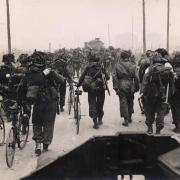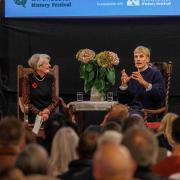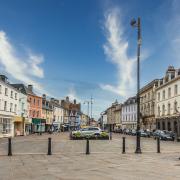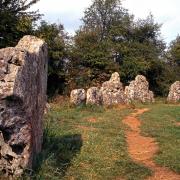Having previously penned Roman, Tudor, Stuart, Georgian and Victorian Cotswolds (although not necessarily in the right order as Eric Morecambe might have said), it occurred to me that I should write another about Medieval Cotswolds, or the Middle Ages as it’s also known (handily too, as from our perspective it’s the bit in the middle, kind of in between the Dark Ages and modern times). As for when Medieval times played out, well, I’m plumping for the Norman Conquest (1066) to the day the ‘Car Park King’ (Richard III) became the last English king to expire in battle (1485); that should do it. It’s a rollicking period then of just over four centuries.
![Berkeley Castle, scene of the final denouement of Edward II]() Berkeley Castle, scene of the final denouement of Edward II (Image: Adrian Farwell/web.archive.org) I may have to cut my cloth (apt that considering the Medieval cloth trade) as four centuries is a lot to cover and the Cotswolds can grow into quite a big area. I’ll therefore stick mostly to Gloucestershire and will leave bits out; I won’t even mention every king for there were 17 of them from the Conqueror to the ‘Car Park’. No account of Medieval mayhem in the Cotswolds would be complete without a mention for Berkeley where a gawp from the fields espies a castle seemingly mostly of the 14th century, including its great hall, however, there’s also a Norman keep erected in the reign of Henry II. It’s a castle that’s had ‘its share of gruesomeness’ according to my bulky guide to the West Mids including the ‘frightful murder’ of Edward II (1327). ‘Kniphofia’ one’s tempted to add; that’s a red hot poker to you and me. On a happier note I’d like to do a shout-out for Gloucester Cathedral with its Norman plan and pillars up its 174-foot nave which date to its first building period (1089-1100). I could write an article solely on this place. Suffice to say that its 225-foot pinnacled tower took 100 years to complete and was finished during the fractious Wars of the Roses of the 15th century, plus its best bit of medieval funerary art is the tomb of Edward II, his remains dutifully interred here by the monks in 1337. The place didn’t become a cathedral until the reign of Henry VIII. Tewkesbury Abbey is also one to gawp at, its Norman nave and tower, 132 feet high, comparable with any to be found in southern England.
Berkeley Castle, scene of the final denouement of Edward II (Image: Adrian Farwell/web.archive.org) I may have to cut my cloth (apt that considering the Medieval cloth trade) as four centuries is a lot to cover and the Cotswolds can grow into quite a big area. I’ll therefore stick mostly to Gloucestershire and will leave bits out; I won’t even mention every king for there were 17 of them from the Conqueror to the ‘Car Park’. No account of Medieval mayhem in the Cotswolds would be complete without a mention for Berkeley where a gawp from the fields espies a castle seemingly mostly of the 14th century, including its great hall, however, there’s also a Norman keep erected in the reign of Henry II. It’s a castle that’s had ‘its share of gruesomeness’ according to my bulky guide to the West Mids including the ‘frightful murder’ of Edward II (1327). ‘Kniphofia’ one’s tempted to add; that’s a red hot poker to you and me. On a happier note I’d like to do a shout-out for Gloucester Cathedral with its Norman plan and pillars up its 174-foot nave which date to its first building period (1089-1100). I could write an article solely on this place. Suffice to say that its 225-foot pinnacled tower took 100 years to complete and was finished during the fractious Wars of the Roses of the 15th century, plus its best bit of medieval funerary art is the tomb of Edward II, his remains dutifully interred here by the monks in 1337. The place didn’t become a cathedral until the reign of Henry VIII. Tewkesbury Abbey is also one to gawp at, its Norman nave and tower, 132 feet high, comparable with any to be found in southern England.
![The magnificent church in Chipping Campden with its elegant 15th century pinnacled tower]() The magnificent church in Chipping Campden with its elegant 15th century pinnacled tower (Image: Steve Roberts) A lot of the Cotswolds’ Middle Ages wealth was built on wool. It’s amazing how much dosh a flock of sheep can generate. There are lots of places that help tell the story. Bibury has an old church of Anglo-Saxon origin yet with Norman and other additions. Check out the graveyard though; those splendid tombs speak of woollen wealth. Chipping Campden would be a good place to breathe in some of that wealth; it’s one of the archetypal towns of those affluent woolly merchants of the 14th and 15th centuries. There’s lots of stone buildings that speak of a richer market town of the late Middle Ages such as the arched and timber roofed Market Hall. Then there’s the magnificent Perpendicular church with its elegant 15th century pinnacled tower and lots of other bits of that century when the town’s prosperity peaked. Cirencester owed its post-Roman prosperity to the monks of the abbey who not only completed their great church in the reign of Henry II but also got sheep rearing on the rich meadows surrounding the town. Although nought remains of the abbey other than a late-Norman gateway, the town would get another spanking great church courtesy of its wool merchants. St John the Baptist is indeed one of the greatest of all the ‘wool churches’ with its splendiferous tower and three-storey fan-vaulted porch. If you’ve not seen it you’ve not lived. Fairford’s St Mary’s rivals it. It’s one of the best surviving of the wool churches and was built in the latter 15th century by John Tame, a wealthy cloth merchant. Northleach was another of the prosperous wool towns, its lofty 15th century Perpendicular church with its beautiful south porch another monument to the money that was made. There’s a brass to John Fortey (died 1458) who built the nave; his feet rest on a wool sack and sheep. Stow is the Cotswolds’ highest town but it was also once the most thriving wool market in the kingdom. The parish church of St Edward’s, with its sturdy 15th century tower, has all architectural ages represented from the Normans onwards. Dursley’s church has a fine 15th century chapel bestowed on it by one of the town’s wool merchants; you feel they must have come equipped with their own cement mixers.
The magnificent church in Chipping Campden with its elegant 15th century pinnacled tower (Image: Steve Roberts) A lot of the Cotswolds’ Middle Ages wealth was built on wool. It’s amazing how much dosh a flock of sheep can generate. There are lots of places that help tell the story. Bibury has an old church of Anglo-Saxon origin yet with Norman and other additions. Check out the graveyard though; those splendid tombs speak of woollen wealth. Chipping Campden would be a good place to breathe in some of that wealth; it’s one of the archetypal towns of those affluent woolly merchants of the 14th and 15th centuries. There’s lots of stone buildings that speak of a richer market town of the late Middle Ages such as the arched and timber roofed Market Hall. Then there’s the magnificent Perpendicular church with its elegant 15th century pinnacled tower and lots of other bits of that century when the town’s prosperity peaked. Cirencester owed its post-Roman prosperity to the monks of the abbey who not only completed their great church in the reign of Henry II but also got sheep rearing on the rich meadows surrounding the town. Although nought remains of the abbey other than a late-Norman gateway, the town would get another spanking great church courtesy of its wool merchants. St John the Baptist is indeed one of the greatest of all the ‘wool churches’ with its splendiferous tower and three-storey fan-vaulted porch. If you’ve not seen it you’ve not lived. Fairford’s St Mary’s rivals it. It’s one of the best surviving of the wool churches and was built in the latter 15th century by John Tame, a wealthy cloth merchant. Northleach was another of the prosperous wool towns, its lofty 15th century Perpendicular church with its beautiful south porch another monument to the money that was made. There’s a brass to John Fortey (died 1458) who built the nave; his feet rest on a wool sack and sheep. Stow is the Cotswolds’ highest town but it was also once the most thriving wool market in the kingdom. The parish church of St Edward’s, with its sturdy 15th century tower, has all architectural ages represented from the Normans onwards. Dursley’s church has a fine 15th century chapel bestowed on it by one of the town’s wool merchants; you feel they must have come equipped with their own cement mixers.
![Chipping Sodbury's Town Hall, initially of the 15th century but which, along with numerous Cotswold churches, attracted the attentions of Victorian restorers often with mixed results]() Chipping Sodbury's Town Hall, initially of the 15th century but which, along with numerous Cotswold churches, attracted the attentions of Victorian restorers often with mixed results (Image: Ray Bird / Town Hall, Broad Street, Chipping) We could spend a lifetime just gallivanting around all the Medieval churches in the Cotswolds. I won’t be able to mention them all but to give you a flavour there’s Bourton-on-the-Hill where St Lawrence’s has a super south arcade of Norman persuasion whilst Bourton-on-the-Water’s parish church has a chancel of 1328. Lower Slaughter’s church has a 12th century arcade; Upper Slaughter’s competes with sound Norman features and an odd sanctus bellcot. Things are swell at the Swells too. Lower Swell’s church has especially fine Norman carving; Upper Swell’s has a stout Norman doorway and a 15th century porch that seems as good as new. We Medievalists must beware of the Victorian ‘restorers’ though. They were active at Bourton-on-the-Water and the Slaughters with mixed results. Chedworth’s worth a visit, its church replete with Norman bits, an arcade, aisle, font and tower, although the latter has a 13th century belfry, presumably with the odd Plantagenet bat in residence. Chipping Sodbury has a Town Hall and church of the 15th century although both attracted the attentions of those pesky Victorians in the mid-19th century. What was the matter with them? The church benefits from some older bits too. Sheepscombe’s 14th century church was another to fall foul of the Victorians as did Slimbridge’s St John’s although it still contains some of the best examples of medieval stonework in England (check out the beautiful capitals in the late-12th century nave arcades). Nymphsfield’s church has a good 15th century tower, but, you guessed it, the Victorians botched the church’s restoration.
Chipping Sodbury's Town Hall, initially of the 15th century but which, along with numerous Cotswold churches, attracted the attentions of Victorian restorers often with mixed results (Image: Ray Bird / Town Hall, Broad Street, Chipping) We could spend a lifetime just gallivanting around all the Medieval churches in the Cotswolds. I won’t be able to mention them all but to give you a flavour there’s Bourton-on-the-Hill where St Lawrence’s has a super south arcade of Norman persuasion whilst Bourton-on-the-Water’s parish church has a chancel of 1328. Lower Slaughter’s church has a 12th century arcade; Upper Slaughter’s competes with sound Norman features and an odd sanctus bellcot. Things are swell at the Swells too. Lower Swell’s church has especially fine Norman carving; Upper Swell’s has a stout Norman doorway and a 15th century porch that seems as good as new. We Medievalists must beware of the Victorian ‘restorers’ though. They were active at Bourton-on-the-Water and the Slaughters with mixed results. Chedworth’s worth a visit, its church replete with Norman bits, an arcade, aisle, font and tower, although the latter has a 13th century belfry, presumably with the odd Plantagenet bat in residence. Chipping Sodbury has a Town Hall and church of the 15th century although both attracted the attentions of those pesky Victorians in the mid-19th century. What was the matter with them? The church benefits from some older bits too. Sheepscombe’s 14th century church was another to fall foul of the Victorians as did Slimbridge’s St John’s although it still contains some of the best examples of medieval stonework in England (check out the beautiful capitals in the late-12th century nave arcades). Nymphsfield’s church has a good 15th century tower, but, you guessed it, the Victorians botched the church’s restoration.
![Minchinhampton and its market house. Matilda, wife of William the Conqueror, asked him to grant the manor of Hampton to a newly-founded abbey in Caen]() Minchinhampton and its market house. Matilda, wife of William the Conqueror, asked him to grant the manor of Hampton to a newly-founded abbey in Caen (Image: Ethan Doyle White) Down Ampney’s church has a 15th century buttressed porch, early-13th century arcade and arches resting on Norman pillars. Vaughan Williams was born in the village so should have composed music about it. Elkstone, mentioned in the Domesday Book, has one of Gloucestershire’s best Norman churches, whilst Syde, across the road, keeps up with its own old Norman place of worship. Lechlade’s St Lawrence’s is 15th century, has an elegant spire which dominates its village and an exquisitely ornamented chancel roof. North Cerney’s church is Norman/Early English, its west tower begun by the Normans and completed in the next century, its south door replete with Norman ornamentation. Marshfield has a different religious offering, a great 15th century tithe barn with 15 magnificent bays. Minchinhampton has ancient ties to Normandy, as Matilda, wife of the Conqueror, asked her hubby to present the Manor of Hampton to a newly-founded abbey in Caen. She registers at Thornbury too as William bestowed the manor and lands here on Matilda at the time of the Conquest.
Minchinhampton and its market house. Matilda, wife of William the Conqueror, asked him to grant the manor of Hampton to a newly-founded abbey in Caen (Image: Ethan Doyle White) Down Ampney’s church has a 15th century buttressed porch, early-13th century arcade and arches resting on Norman pillars. Vaughan Williams was born in the village so should have composed music about it. Elkstone, mentioned in the Domesday Book, has one of Gloucestershire’s best Norman churches, whilst Syde, across the road, keeps up with its own old Norman place of worship. Lechlade’s St Lawrence’s is 15th century, has an elegant spire which dominates its village and an exquisitely ornamented chancel roof. North Cerney’s church is Norman/Early English, its west tower begun by the Normans and completed in the next century, its south door replete with Norman ornamentation. Marshfield has a different religious offering, a great 15th century tithe barn with 15 magnificent bays. Minchinhampton has ancient ties to Normandy, as Matilda, wife of the Conqueror, asked her hubby to present the Manor of Hampton to a newly-founded abbey in Caen. She registers at Thornbury too as William bestowed the manor and lands here on Matilda at the time of the Conquest.
![The fields towards the top of Greenhill in Evesham where the Battle of Evesham was fought on 4th August 1265]() The fields towards the top of Greenhill in Evesham where the Battle of Evesham was fought on 4th August 1265 (Image: Steve Roberts) Of course, Medieval life wasn’t just about chucking up castles, abbeys and churches. There was serious fighting and dying to be done. The 13th century saw two Barons’ Wars, the second of them culminating in the bloodbath at Evesham (1265); sorry, a slight detour into Worcestershire there. The 14th century added the Black Death and the Peasants’ Revolt to the mix. Those peasants, they truly were revolting. The 15th century saw another bloodbath at Tewkesbury (1471) as Edward IV cemented his position as our first Yorkist king. By and large though life in the Cotswolds ticked on, the sheep ruminated and the cement mixers revolved. The Normans, of course, began building castles on green belt land to subdue the English, but Gloucestershire is also border country and other strongholds would rise to deter Welsh marauders, a 13th century example having been at St Briavels in the Forest of Dean. There’s remains there covering over an acre. There’s also a Norman church. There was also a bit of time for pleasure, especially if you were rich (much like today then). Edward III granted a privilege in 1355 which saw a hunting lodge at Prinknash, which would be restored during the reign of Henry VIII. Talking of the well-off, one Dick Whittington (died 1423) was born in the late-1350s at Pauntley and contrary to the panto came from a knightly family but it’s true that he went to London and became a four-time Lord Mayor. The church here is 12th century, its tower quite possibly a benefaction of Dick himself.
The fields towards the top of Greenhill in Evesham where the Battle of Evesham was fought on 4th August 1265 (Image: Steve Roberts) Of course, Medieval life wasn’t just about chucking up castles, abbeys and churches. There was serious fighting and dying to be done. The 13th century saw two Barons’ Wars, the second of them culminating in the bloodbath at Evesham (1265); sorry, a slight detour into Worcestershire there. The 14th century added the Black Death and the Peasants’ Revolt to the mix. Those peasants, they truly were revolting. The 15th century saw another bloodbath at Tewkesbury (1471) as Edward IV cemented his position as our first Yorkist king. By and large though life in the Cotswolds ticked on, the sheep ruminated and the cement mixers revolved. The Normans, of course, began building castles on green belt land to subdue the English, but Gloucestershire is also border country and other strongholds would rise to deter Welsh marauders, a 13th century example having been at St Briavels in the Forest of Dean. There’s remains there covering over an acre. There’s also a Norman church. There was also a bit of time for pleasure, especially if you were rich (much like today then). Edward III granted a privilege in 1355 which saw a hunting lodge at Prinknash, which would be restored during the reign of Henry VIII. Talking of the well-off, one Dick Whittington (died 1423) was born in the late-1350s at Pauntley and contrary to the panto came from a knightly family but it’s true that he went to London and became a four-time Lord Mayor. The church here is 12th century, its tower quite possibly a benefaction of Dick himself.
![The inner face of the gatehouse at St Briavels Castle, Forest of Dean, which unlike most Norman castles was not built to keep the English down; this one was built primarily to keep the Welsh in check]() The inner face of the gatehouse at St Briavels Castle, Forest of Dean, which unlike most Norman castles was not built to keep the English down; this one was built primarily to keep the Welsh in check (Image: Hchc2009) CHRONOLOGY
The inner face of the gatehouse at St Briavels Castle, Forest of Dean, which unlike most Norman castles was not built to keep the English down; this one was built primarily to keep the Welsh in check (Image: Hchc2009) CHRONOLOGY
1066 – Defeat and death of Harold II at Hastings ushers in the Norman era.
1086 – Elkstone is mentioned in William the Conqueror’s Domesday Book.
1100 – Norman pillars completed up the nave of today’s Gloucester Cathedral.
1265 – The Battle of Evesham sees the royal army defeat the rebels of Simon de Montfort.
1327 – Edward II is gruesomely done to death in Berkeley Castle; Kniphofia folks.
1355 – Edward III grants a privilege enabling a hunting lodge to be established at Prinknash.
1423 – Death of Dick Whittington, the four-time Lord Mayor of London, born in Pauntley.
1458 – Death of John Fortey who built the nave at Northleach. He has a brass in the church.
1471 – The Battle of Tewkesbury sees Edward IV defeat his Lancastrian rivals.
1485 – The Battle of Bosworth effectively ends the Wars of the Roses.

































